Sensitivity Analysis of the Surface Runoff Coefficient of HiPIMS in Simulating Flood Processes in a Large Basin
Abstract
:1. Introduction
2. Materials and Methods
2.1. HiPIMS
2.2. Error Functions
2.3. Study Area
2.4. Typical Flood Processes and Surface Runoff Coefficients
- (1)
- Three different types of flood processes (FPs) were chosen to represent big, medium, and small floods, respectively, as shown in Table 2.
- (2)
- Four types of surface runoff coefficient (SRC) were assumed a priori as below: SRC1 = 0.55, for all grid cells; SRC2 = 0.65, for all grid cells; SRC3 = 0.75, for all grid cells; SRC4: each grid cell was given a SRC based on its land use type—1.0 for urban/pond/river, 0.85 for bared land, 0.7 for farmland/grassland, and 0.5 for forest/heavy brush, as shown in Figure 3.
- (3)
- As such, the above-mentioned FP1, FP2, FP3 and SRC1, SRC2, SRC3, SRC4 then formed twelve combinations and were used for the sensitivity analysis in the following sections. The combination is denoted FPi-SRCj hereafter, e.g., FP1-SRC1 representing FP1 under SRC1.
2.5. Modelling Set
3. Results and Discussion
4. Conclusions
Acknowledgments
Author Contributions
Conflicts of Interest
References
- Kundzewicz, Z.W.; Kanae, S.; Seneviratne, S.I.; Handmer, J.; Nicholls, N.; Peduzzi, P.; Mechler, R.; Bouwer, L.M.; Arnell, N.; Mach, K.; et al. Flood risk and climate change: Global and regional perspectives. Hydrol. Sci. J. 2014, 59, 1–28. [Google Scholar] [CrossRef]
- Hirabayashi, Y.; Mahendran, R.; Koirala, S.; Konoshima, L.; Yamazaki, D.; Watanabe, S.; Kim, H.; Kanae, S. Global flood risk under climate change. Nat. Clim. Chang. 2013, 3, 816–821. [Google Scholar] [CrossRef]
- Wang, Y.; Yang, X. Assessing the effect of land use/cover change on flood in Beijing, China. Front. Environ. Sci. Eng. 2013, 7, 769–776. [Google Scholar] [CrossRef]
- Yang, X.; Chen, H.; Wang, Y.; Xu, C. Evaluation of the effect of land use/cover change on flood characteristics using an integrated approach coupling land and flood analysis. Hydrol. Res. 2016, 47, 1161–1171. [Google Scholar] [CrossRef]
- Intergovernmental Panel on Climate Change (IPCC). Summary for Policymakers. In Climate Change 2013: The Physical Science Basis. Contribution of Working Group I to the Fifth Assessment Report of the Intergovernmental Panel on Climate Change; Stocker, T.F., Qin, D., Plattner, G.K., Tignor, M., Allen, S.K., Boschung, J., Nauels, A., Xia, Y., Bex, V., Midgley, P.M., Eds.; Cambridge University Press: Cambridge, UK, 2013; p. 23. [Google Scholar]
- Borga, M.; Anagnostou, E.N.; Blöschl, G.; Creutin, J.-D. Flash flood forecasting, warning and risk management: The HYDRATE project. Environ. Sci. Policy 2011, 14, 834–844. [Google Scholar] [CrossRef]
- Liang, Q.; Xia, X.; Hou, J. Efficient urban flood simulation using a GPU-accelerated SPH model. Environ. Earth Sci. 2015, 74, 7285–7294. [Google Scholar] [CrossRef]
- Yang, T.H.; Yang, S.C.; Ho, J.Y.; Lin, G.F.; Hwang, G.D.; Lee, C.S. Flash flood warnings using the ensemble precipitation forecasting technique: A case study on forecasting floods in Taiwan caused by typhoons. J. Hydrol. 2015, 520, 367–378. [Google Scholar] [CrossRef]
- Douinot, A.; Roux, H.; Garambois, P.A.; Larnier, K.; Labat, D.; Dartus, D. Accounting for rainfall systematic spatial variability in flash flood forecasting. J. Hydrol. 2016, 541, 359–370. [Google Scholar] [CrossRef]
- Miao, Q.; Yang, D.; Yang, H.; Li, Z. Establishing a rainfall threshold for flash flood warnings in China’s mountainous areas based on a distributed hydrological model. J. Hydrol. 2016, 541, 371–386. [Google Scholar] [CrossRef]
- Barbetta, S.; Coccia, G.; Moramarco, T.; Brocca, L.; Todini, E. The multi temporal/multi-model approach to predictive uncertainty assessment in real-time flood forecasting. J. Hydrol. 2017, 551, 555–576. [Google Scholar] [CrossRef]
- Wang, Y.; Liang, Q.; Georges, K.; Jim, W.H. A 2D shallow flow model for practical dam-break simulations. J. Hydraul. Res. 2011, 49, 307–316. [Google Scholar] [CrossRef]
- Hou, J.; Simons, F.; Mahgoub, M.; Hinkelmann, R. A robust well-balanced model on unstructured grids for shallow water flows with wetting and drying over complex topography. Comput. Methods Appl. Mech. Eng. 2013, 257, 126–149. [Google Scholar] [CrossRef]
- Roberts, S.; Nielsen, O.; Gray, D.; Sexton, J.; Davies, G. ANUGA User Manual, Release 2.0; Commonwealth of Australia (Geoscience Australia) and the Australian National University: Canberra, Australia, 2015. [CrossRef]
- Singh, V.P.; Aravamuthan, V. Errors of kinematic-wave and diffusion-wave approximations for steady-state overland flows. CATENA 1996, 27, 209–227. [Google Scholar] [CrossRef]
- Bates, P.D.; Horritt, M.S.; Fewtrell, T.J. A simple inertial formulation of the shallow water equations for efficient two-dimensional flood inundation modelling. J. Hydrol. 2010, 387, 33–45. [Google Scholar] [CrossRef]
- Pender, G.; Néelz, S. Benchmarking of 2D Hydraulic Modelling Packages; Science Report, SC080035/SR2; Environment Agency: Bristol, UK, 2010.
- Liang, Q.; Borthwick, A.G.L.; Stelling, G. Simulation of dam- and dyke-break hydrodynamics on dynamically adaptive quadtree grids. Int. J. Numer. Meth. Fluids 2004, 46, 127–162. [Google Scholar] [CrossRef]
- Smith, L.S.; Liang, Q. Towards a generalised GPU/CPU shallow-flow modelling tool. Comput. Fluids 2013, 88, 334–343. [Google Scholar] [CrossRef]
- Smith, L.S.; Liang, Q. A High-Performance Integrated Hydrodynamic Modelling System for urban flood simulations. J. Hydroinform. 2015, 17, 518–533. [Google Scholar] [CrossRef]
- Liang, Q.; Xia, X.; Hou, J. Catchment-scale high-resolution flash flood simulation using the GPU-based technology. Procedia Eng. 2016, 154, 975–981. [Google Scholar] [CrossRef]
- Liang, Q.; Smith, L.; Xia, X. New prospects for computational hydraulics by leveraging high-performance heterogeneous computing techniques. J. Hydrodyn. 2016, 28, 977–985. [Google Scholar] [CrossRef]
- Bellos, V.; Tsakiris, G. A hybrid method for flood simulation in small catchments combining hydrodynamic and hydrological techniques. J. Hydrol. 2016, 540, 331–339. [Google Scholar] [CrossRef]
- Yin, J.; Yu, D.; Yin, Z.; Liu, M.; He, Q. Evaluating the impact and risk of pluvial flash flood on intra-urban road network: A case study in the city center of Shanghai, China. J. Hydrol. 2016, 537, 138–145. [Google Scholar] [CrossRef] [Green Version]
- Mudd, S.M. Investigation of the hydrodynamics of flash floods in ephemeral channels: Scaling analysis and simulation using a shock-capturing flow model incorporating the effects of transmission losses. J. Hydrol. 2006, 324, 65–79. [Google Scholar] [CrossRef]
- Jin, S. Asymptotic preserving (AP) schemes for multiscale kinetic and hyperbolic equations: A review. Lecture Notes for Summer School on ‘‘Methods and Models of Kinetic Theory” (M&MKT), Porto Ercole (Grosseto, Italy), June 2010. Riv. Mat. Univ. Parma 2012, 3, 177–216. [Google Scholar]
- Xia, X.; Liang, Q.; Ming, X.; Hou, J. An efficient and stable hydrodynamic model with novel source term discretisation for overland flow and flood simulations. Water Resour. Res. 2017, 53, 3730–3759. [Google Scholar] [CrossRef]
- Liang, Q.; Borthwick, A.G.L. Adaptive quadtree simulation of shallow flows with wet-dry fronts over complex topography. Comput. Fluids 2009, 38, 221–234. [Google Scholar] [CrossRef]
- Zheng, Z.; He, S.; Wu, F.; Hu, J. Relationship between surface roughness and Manning roughness. J. Mt. Sci. 2004, 22, 236–239. (In Chinese) [Google Scholar] [CrossRef]
- Tang, X. Characteristics of Runoff and Soil Erosion of Typical Forest Types in the Sources of Qiantang River. Master’s Thesis, Zhejiang A&F University, Hangzhou, China, 22 May 2012. (In Chinese). [Google Scholar]
- Huang, J. Evaluation of Anti-Water Erosion Function of Main Forests in the South Hilly and Mountain Region of Jiangsu Province. Ph.D. Thesis, Nanjing Forestry University, Nanjing, China, 16 June 2011. (In Chinese). [Google Scholar]
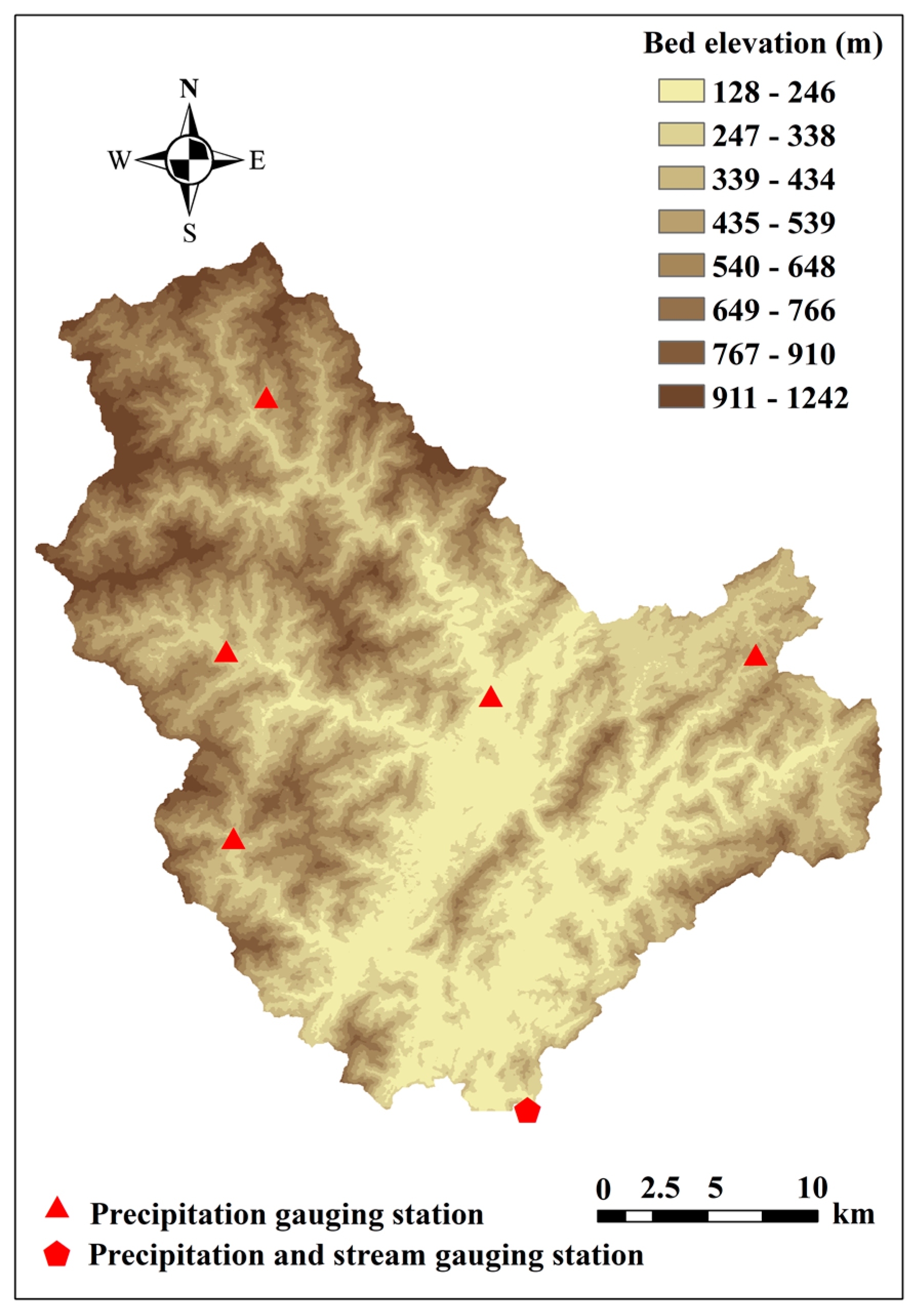
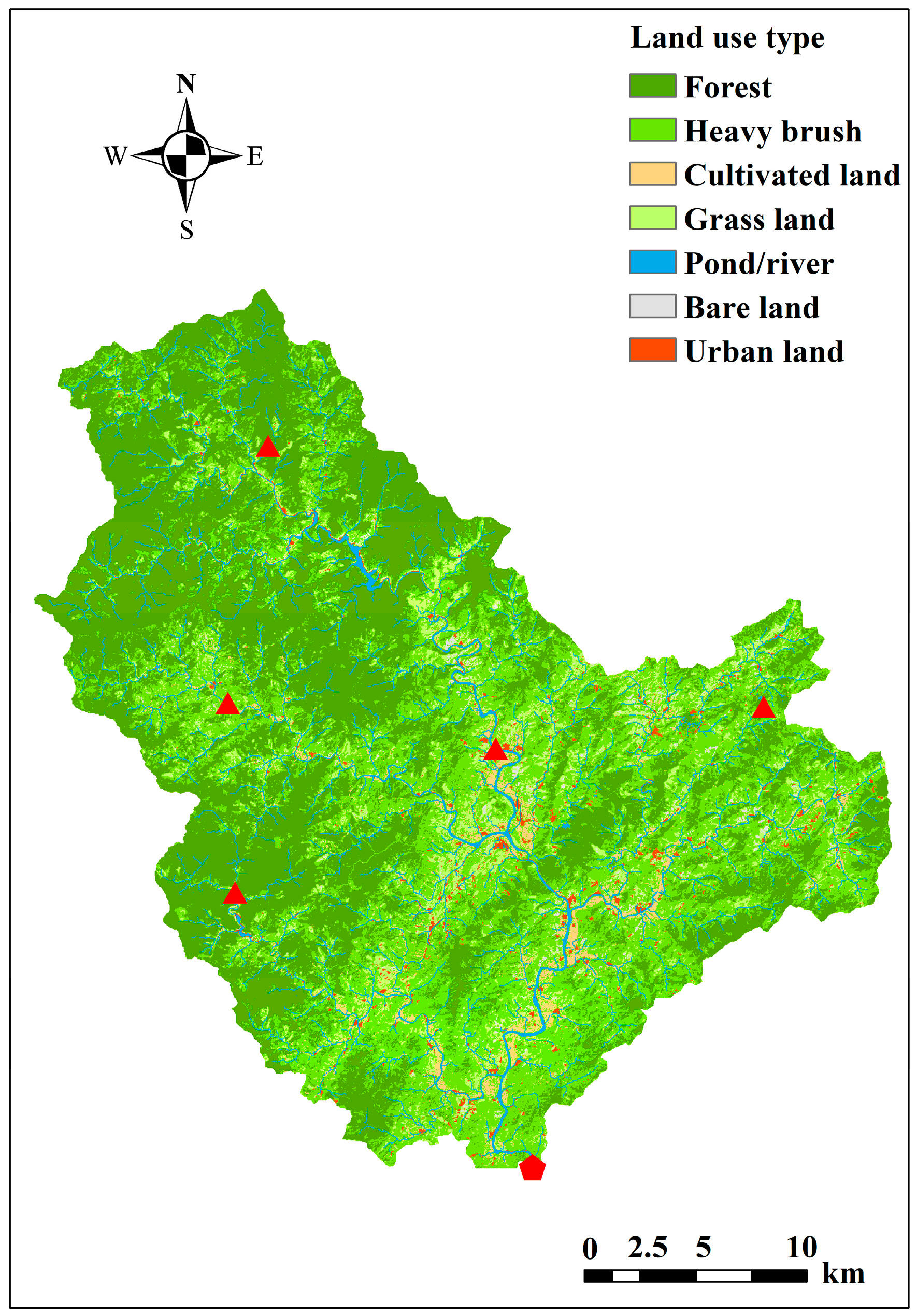
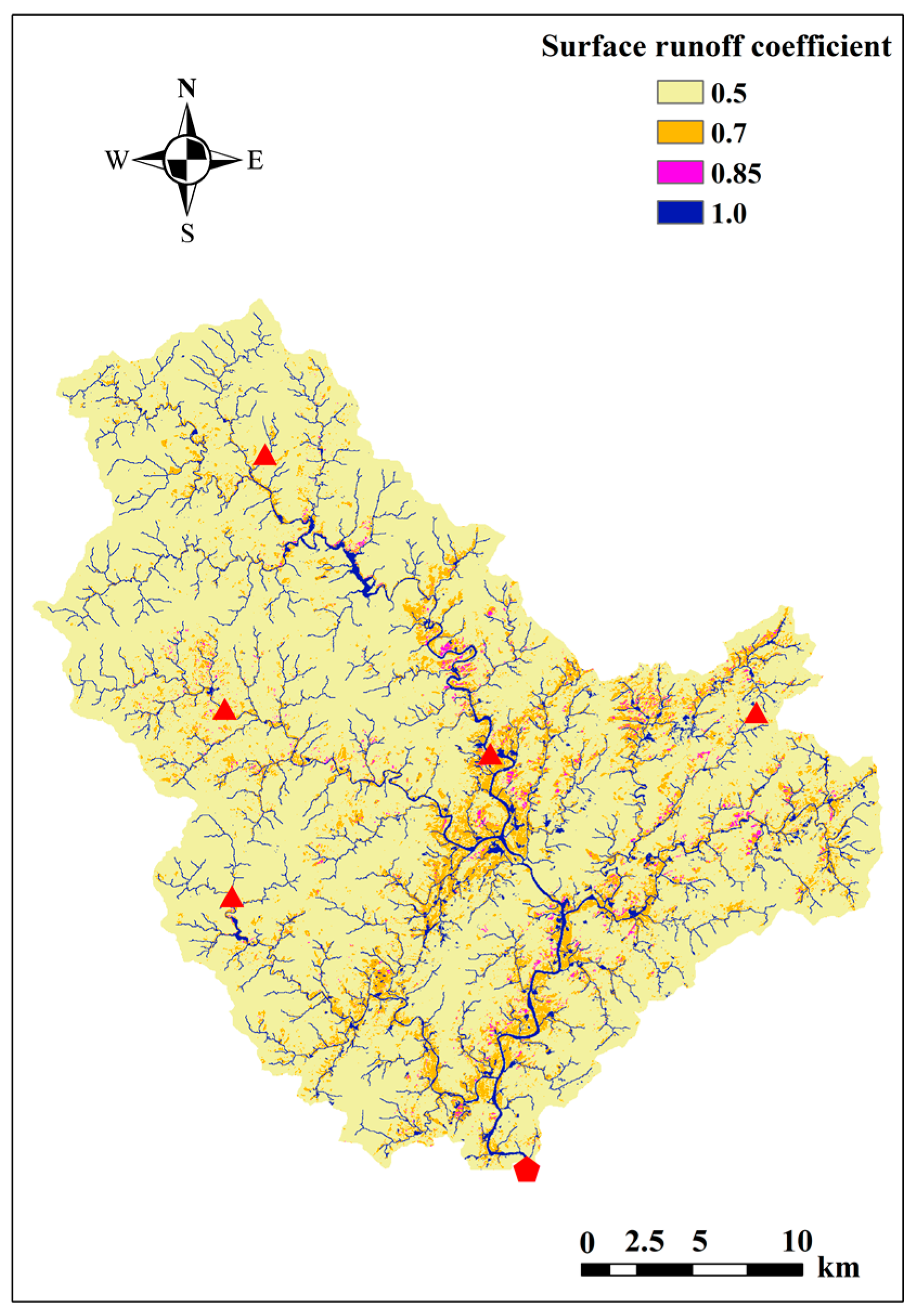
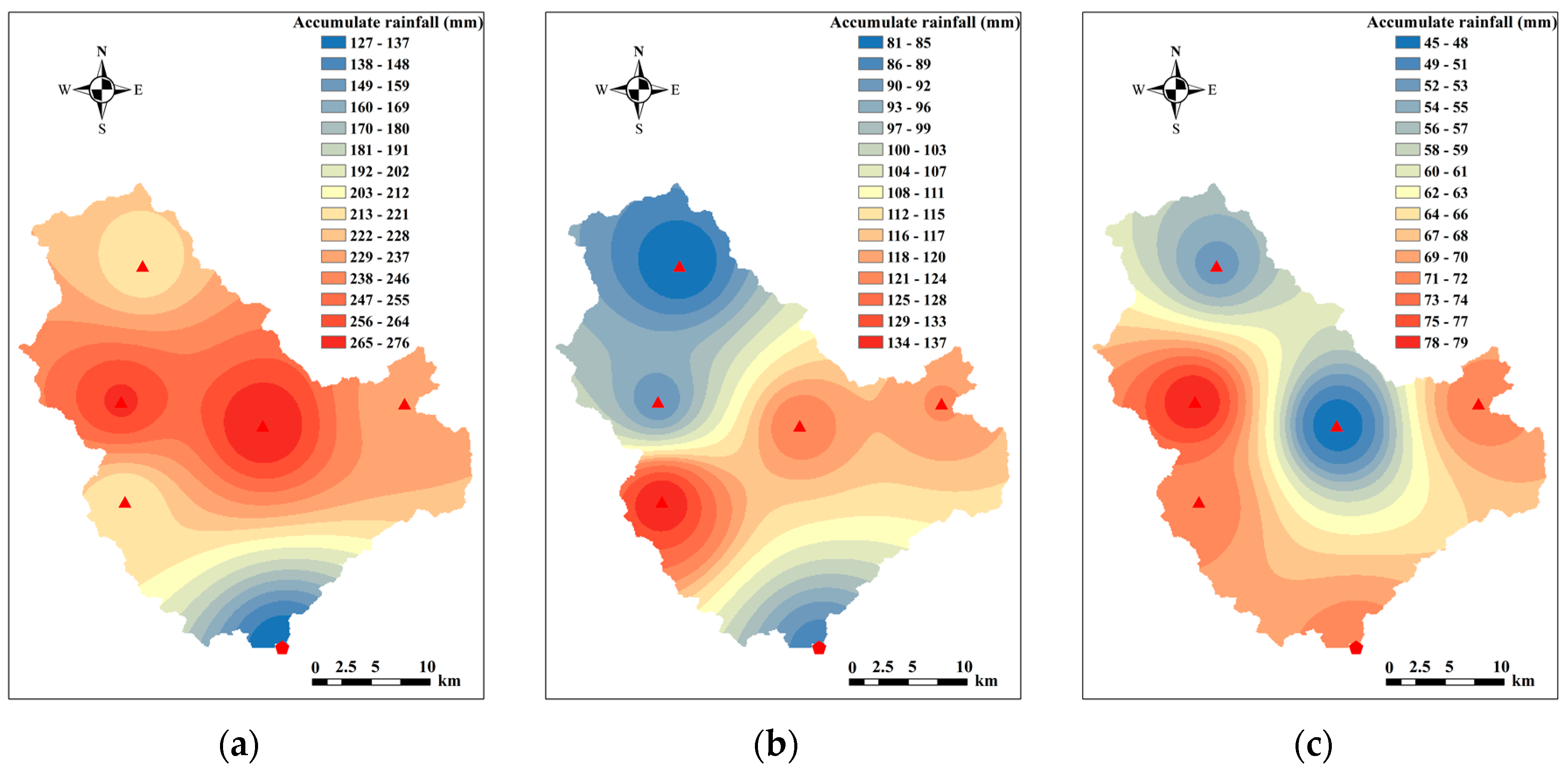
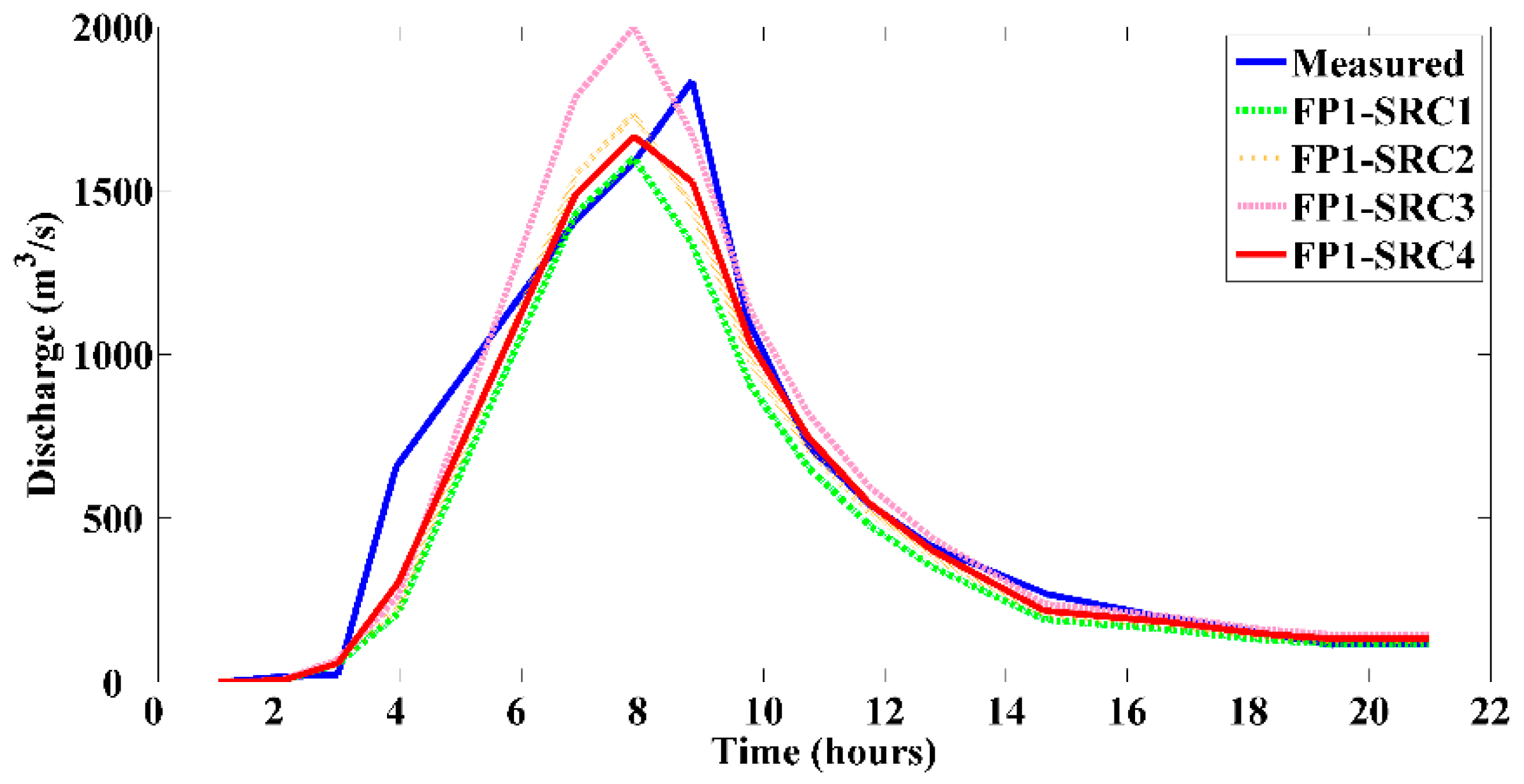

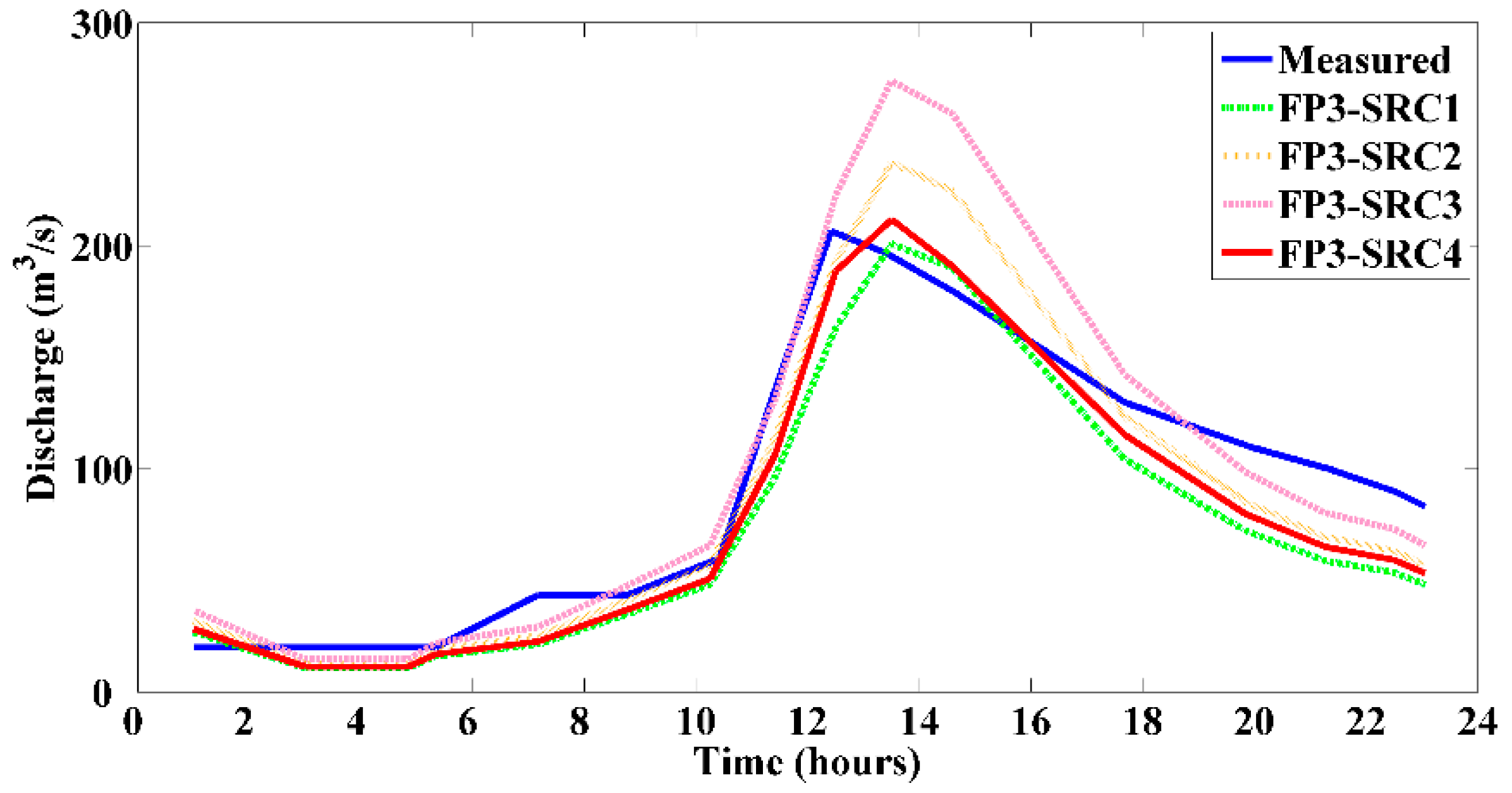
| Land Use Type | Area Proportion (%) | Manning’s n 1 |
|---|---|---|
| Forest | 45.5 | 0.15 |
| Heavy brush | 37.3 | 0.11 |
| Cultivated land | 2.2 | 0.035 |
| Grassland | 7.3 | 0.03 |
| Pond/river | 5.8 | 0.027 |
| Bare land | 0.7 | 0.025 |
| Urban land | 1.2 | 0.016 |
| Name | Start Time | End Time | Rainfall | Peak Flow |
|---|---|---|---|---|
| FP1 (big) | 29 May 1983, 8:00 | 30 May 1983, 13:00 | 222 mm | 1820 m3/s |
| FP2 (medium) | 5 May 1985, 8:00 | 7 May 1985, 12:00 | 106 mm | 708 m3/s |
| FP3 (small) | 26 May 1987, 8:00 | 27 May 1987, 20:00 | 65 mm | 202 m3/s |
| Combination | Measured Q (m3/s) | Simulated Q (m3/s) | ARED (%) | DPAT (h) | NSE |
|---|---|---|---|---|---|
| FP1-SRC1 | 1820 | 1599 | 12.1 | −1 | 0.91 |
| FP1-SRC2 | 1820 | 1732 | 4.8 | −1 | 0.93 |
| FP1-SRC3 | 1820 | 1999 | 9.8 | −1 | 0.90 |
| FP1-SRC4 | 1820 | 1665 | 8.5 | −1 | 0.95 |
| FP2-SRC1 | 708 | 744 | 5.0 | 0 | 0.90 |
| FP2-SRC2 | 708 | 789 | 11.4 | 0 | 0.85 |
| FP2-SRC3 | 708 | 874 | 23.4 | 0 | 0.70 |
| FP2-SRC4 | 708 | 721 | 1.8 | 0 | 0.94 |
| FP3-SRC1 | 202 | 201 | 0.5 | 1 | 0.81 |
| FP3-SRC2 | 202 | 238 | 17.8 | 1 | 0.86 |
| FP3-SRC3 | 202 | 274 | 35.6 | 1 | 0.76 |
| FP3-SRC4 | 202 | 212 | 5.0 | 1 | 0.88 |
© 2018 by the authors. Licensee MDPI, Basel, Switzerland. This article is an open access article distributed under the terms and conditions of the Creative Commons Attribution (CC BY) license (http://creativecommons.org/licenses/by/4.0/).
Share and Cite
Wang, Y.; Yang, X. Sensitivity Analysis of the Surface Runoff Coefficient of HiPIMS in Simulating Flood Processes in a Large Basin. Water 2018, 10, 253. https://doi.org/10.3390/w10030253
Wang Y, Yang X. Sensitivity Analysis of the Surface Runoff Coefficient of HiPIMS in Simulating Flood Processes in a Large Basin. Water. 2018; 10(3):253. https://doi.org/10.3390/w10030253
Chicago/Turabian StyleWang, Yueling, and Xiaoliu Yang. 2018. "Sensitivity Analysis of the Surface Runoff Coefficient of HiPIMS in Simulating Flood Processes in a Large Basin" Water 10, no. 3: 253. https://doi.org/10.3390/w10030253





